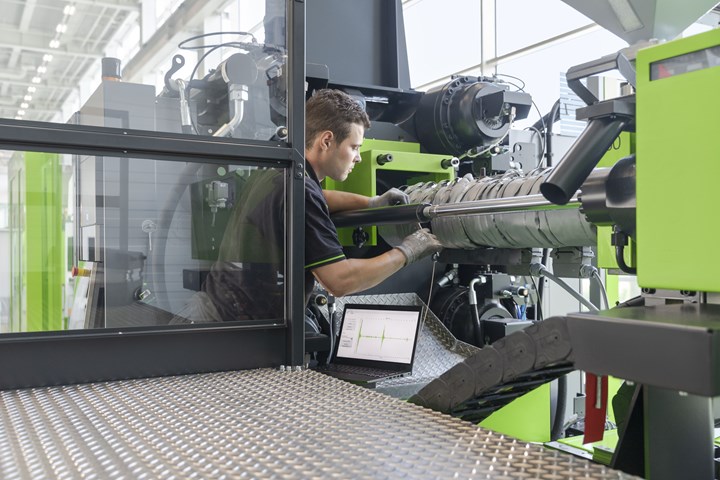Injection Molding: Determine Barrier Screw Condition Without Screw Removal
The device is installed on the outside of the barrel and uses ultrasound to assess a barrier screw’s condition through the barrel wall and the molten plastic.
Injection molding machine and automation supplier Engel (U.S. headquarters in York, Pa.) is extending its condition monitoring platform for condition-based predictive maintenance to barrier screws, using a device that mounts on the barrel and assesses the component without its removal.
For traditional three-zone screws, Engel already developed an e-connect.monitor solution. With barrier screws, however, the the complexity of the screw geometry, including the different pitches of the flights and the wide range of designs, required a new, proprietary algorithm.
Noting that the barrel is normally a “black box” when it comes to maintenance, screw assessments traditionally involve complete removal of the screw in a time-consuming process—time consuming enough that many molders put it off and risk unplanned shutdowns and possible damage to the machine or mold.
Engel says its e‑connect.monitor uses the latest sensor technology in a measuring system that installs on the outside of the barrel. The device applies ultrasound technology to measure the distance between the end of the screw flight and the inside barrel liner, assessing wear over time. If that gap becomes too large, process fluctuations can occur and lead to quality issues.
Engel says one of its service technicians performs the measurement, collecting the required data in “just a few minutes.” The results are transferred to Engel via a secure data link where they are evaluated and interpreted using what the company calls specially developed mathematical models.
Test results are accessible any time via the Engel e-connect customer portal. By checking screw condition an regular, planned intervals, a molder’s maintenance department can determine the wear rate and how it’s trending, helping plan a replacement without an emergency production shutdown.
Engel notes that regular condition monitoring supports process optimization where evaluation of wear parameters helps molders identify and avoid critical process settings that accelerate screw wear. In addition to screws, Engel offers e-connect.monitor modules for hydraulic pumps and oil, as well as ball screws in electric machines.

Related Content
-
Understanding the Effect of Pressure Losses on Injection Molded Parts
The compressibility of plastics as a class of materials means the pressure punched into the machine control and the pressure the melt experiences at the end of fill within the mold will be very different. What does this difference mean for process consistency and part quality?
-
A Systematic Approach to Process Development
The path to a no-baby-sitting injection molding process is paved with data and can be found by following certain steps.
-
Injection Molding: Focus on these Seven Areas to Set a Preventive Maintenance Schedule
Performing fundamental maintenance inspections frequently assures press longevity and process stability. Here’s a checklist to help you stay on top of seven key systems.















